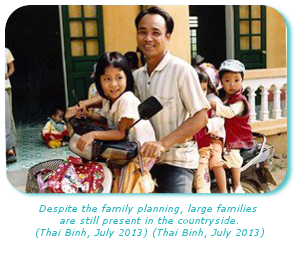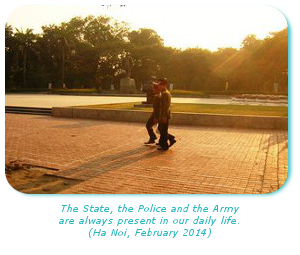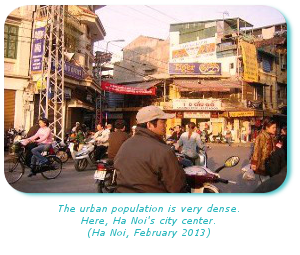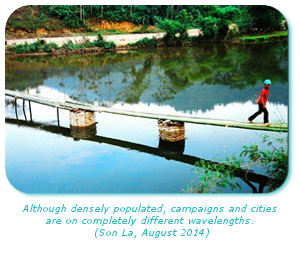Since 1986, Viet Nam tries to make up for lost time and to play in the ‘’big leagues’’. The Country development is both surprisingly fast and on a massive scale. In 20 years of time, it has achieved what took other countries over a hundred years to realize! In the aftermath of reconstruction, Viet Nam shows two different faces: the modern one with urban centers contrasting with life in rural area.
The city life
Cities are growing bigger and ‘’Europeanize’’ themselves day after day. Individual houses are replaced by huge buildings which ground floor accommodates luxury shops, restaurants or automotive dealers. Numerous of cyber coffee shops opened and ‘’state-of-the-art’’ cellphones are omnipresent. The population, who ten years ago was still getting around in bicycles, is now mostly driving in motorbikes. Recently can we see luxury cars taking over two-wheeled vehicles. There is even another project ongoing to build a subway in Ha Noi!
Rural life
The population is still largely rural in Viet Nam (over 70%). Forget about tap water, cars, asphalted roads, and sometimes even electricity! Like all emerging countries, rural areas are not developing as fast as the cities. In rural areas, life follows the rhythms of fields’ labor and agricultural seasons. There, the people do not seek to prosper but to eat. You would be surprise to notice the gap between the cities to the countryside within only a few dozen of kilometers…
A peculiar demography
 The Vietnamese people are young and dynamic. The ‘’baby boom’’ of 1986 was a consequence of the Doi Moi, the Renewal policy. As a result, now 45% of the population is under 20 years old!. Whereas the people over 65 years old only represent 5% of the population! In order to face the population growth, a family planning has been imposed to the population. More flexible than our Chinese neighbors, it restricts the number of two children for one family. The system works out pretty well in the city, which is not necessarily the case in the countryside and for ethnic minorities who struggle to fight against overpopulation. I myself went to some secluded villages where some families have over 10 children!
The Vietnamese people are young and dynamic. The ‘’baby boom’’ of 1986 was a consequence of the Doi Moi, the Renewal policy. As a result, now 45% of the population is under 20 years old!. Whereas the people over 65 years old only represent 5% of the population! In order to face the population growth, a family planning has been imposed to the population. More flexible than our Chinese neighbors, it restricts the number of two children for one family. The system works out pretty well in the city, which is not necessarily the case in the countryside and for ethnic minorities who struggle to fight against overpopulation. I myself went to some secluded villages where some families have over 10 children!
A two-speed economy and rural exodus
The economy of Viet Nam is making astonishing progress and tries to free itself from field labor in order to focus on the finished products trade. In January 2007, the country enters the WTO reaffirming the efforts made by a whole nation in order to enter the global market. Although the average wages are still very low, the development indices are truly promising. Yet, beware of the two-speed economy: when cities encounter a large economic boom, some of the rural areas are showing real signs of impoverishment. Starting from 1986, the Doi Moi ends an era of collectivization of the lands and of agricultural means of production. The state then redistributes almost all the farming lands to the population. A generation passes: each family divides its possessions so that each child can inherit a part of the land. Generations pass, the plots of land become smaller and smaller and prevent largest families from food self-sufficiency. Young people who are looking to diversify their incomes have to face a poorly developed local economy. They are therefore forced to leave for the cities most of the time. “I would like to become a mechanic or a computer engineer, but here we have neither motorbikes nor electricity! I am forced to leave for the city in order to fulfill my dream!’’ a young man from Lao Cai confessed to me lately. Today, the rural exodus is of worrying proportions. Many are the young people without qualifications coming to the city to try out their luck… They do small jobs but since the supply of labor is huge, salaries remain low. Only the skilled labor force’s living standard is able to keep up with the rampant inflation… An urban poverty is starting to develop in the outskirts of big cities and the first housing estates start to grow very fast all around the periphery of Ha Noi and Sai Gon.
.
A few words about politics and territorial organization

Viet Nam is a Socialist Republic under a communist regime of a single Party system. This latter is slowly moving towards a liberal economy, similar to what is happening in China. The Party is still very present in everyday life and civil servants are numerous: police and military, state-owned enterprises as well: hotels, newspapers, gas station, cigarette, coffee and milk factories…In Viet Nam administrative services of organization and control organize themselves in several layers:
![]() The Central Government, is in Hanoi and its roles are legislative and executive and is very similar to the ones from France;
The Central Government, is in Hanoi and its roles are legislative and executive and is very similar to the ones from France;
![]() The Provinces, they can be assimilated to the French regions, indeed they organize life in the area they have been allocated, in accordance to the positions voted by the central government;
The Provinces, they can be assimilated to the French regions, indeed they organize life in the area they have been allocated, in accordance to the positions voted by the central government;
![]() The districts, they receive their missions from the province and are in charge of a certain number of wards;
The districts, they receive their missions from the province and are in charge of a certain number of wards;
![]() The wards, whose members of the popular committee are elected by the population and are responsible of their villages;
The wards, whose members of the popular committee are elected by the population and are responsible of their villages;
![]() The villages, gathering the Vietnamese population.
The villages, gathering the Vietnamese population.






